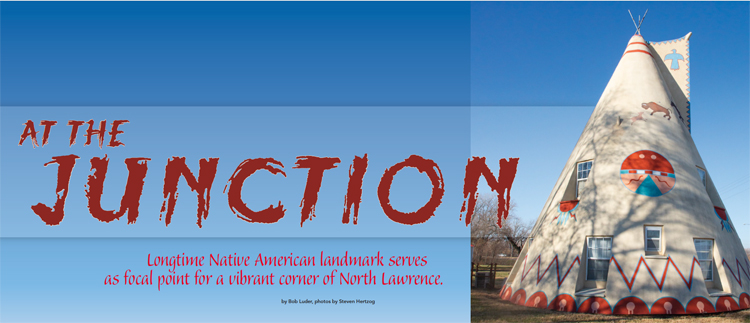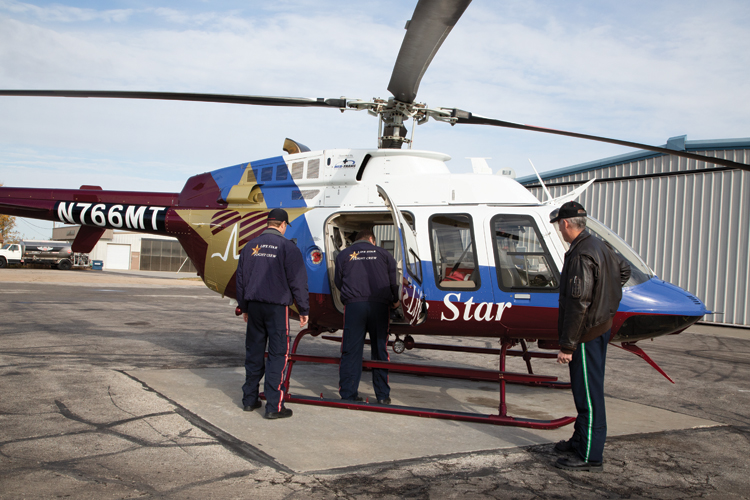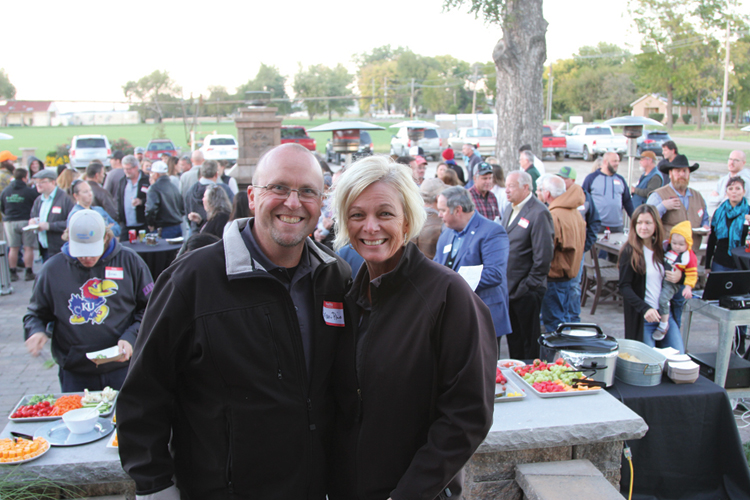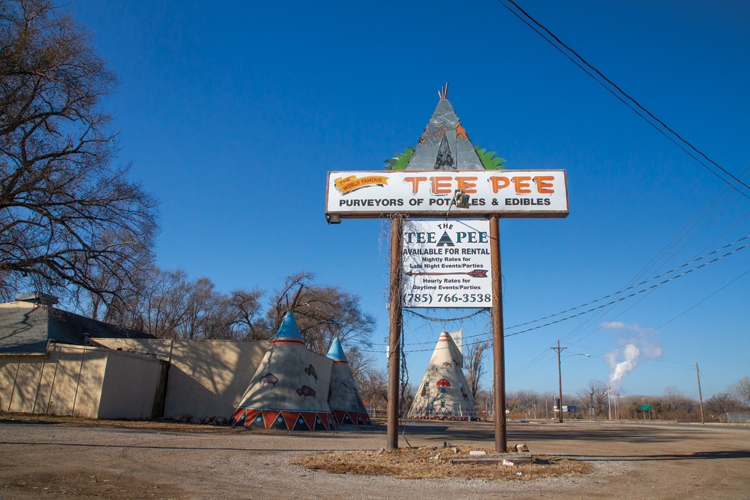Longtime Native American landmark serves as focal point for a vibrant corner of North Lawrence.
| 2018 Q4 | story by writer Bob Luder | photos by Steven Hertzog

For 90 years, it’s stood as a sentry of sorts, watching over the northern edge of North Lawrence and the greater Lawrence community, a vestige of another time and place.
At 50 feet tall, the concrete teepee that sits on an otherwise nondescript piece of earth a couple hundred yards east of Second Street and U.S. Highway 59, off U.S. Highway 40, is hard to miss. When it was built in 1928, it was part of a larger American Indian village, complete with gas station and curio shops.
“The idea back then was that Highway 40 was going to be a major east-to-west highway, like what Interstate 70 is today,” says Richard Osburn, who lives in the teepee and manages the property. “Cars back then could only go 300 miles on a tank of gas, so the thought was it was a perfect spot for travelers to stop, gas up and maybe buy a few souvenirs before heading on.”
When Highway 40 failed to materialize as a major traffic artery, the gas station and village eventually went out of business. But the teepee remains a prominent landmark in the North Lawrence area. Vehicles full of travelers hailing from across the country stop to take photos of themselves standing next to the structure, especially alongside the two painted-on straight lines that serve as a stark record of the water levels during two major floods, in 1935 and 1951.
“Saturday evenings, there are always people out there shooting pictures,” Osburn says. “If I catch people out there, I’ll pop out and offer to take their pictures for them.”
The teepee is such a well-known landmark for North Lawrence that the corner of Highways 59 and 40, and surrounding area has long been tabbed “Teepee Junction” where there are a handful of longstanding North Lawrence businesses.
-
White Schoolhouse
A venerable landmark of the area is the White Schoolhouse, built one year after the teepee in 1929, which has served as a school, college bar and, today, an event space that, among other things, serves as host to concerts put on by local and national independent bands.
Lawrence Municipal Airport
Of utmost importance to the entire Lawrence community is the Lawrence Municipal Airport, which, like the White Schoolhouse, will commemorate its 90th anniversary in 2019 and is the oldest continuously operating airport in the state.
Pine Landscape Center
Pine Landscape Center recently underwent a rebranding and hosted upwards of 200 people at a celebration of the event, began as a traditional farm but, today, provides top-quality landscape materials including rock, sod, soil and mulch.
The Teepee
The Teepee, or rather, the building adjacent to the original teepee (which has two smaller teepees on each side), serves as an events space that’s a popular spot for fraternity and sorority parties.
All are stalwart businesses that bring people and money into North Lawrence as well as contribute to the unique character of the area, enhancing its reputation as a section of the greater Lawrence community that’s on the rise.

Transmit Air Ambulance Service (formerly Life Star) preparing to take off for a pick up and a transport.
Lawrence Municipal Airport
A plaque on the wall in the lobby of the main terminal at Lawrence Municipal Airport commemorates the 1986 dedication of the building, but the history of the airport itself dates back far earlier. In fact, the original airport was dedicated in October 1929, which included the local newspaper’s estimated crowd of 6,000 people. But Rick Bryant, an aviation consultant with Airport Development Group Inc. and unofficial historian for the airport, with more than 20 years of service to the airfield, says actual aviation activity to the community dates back as far as 1910.
According to the June 2, 1976, zzLawrence Journal-Worldzz article “1910 Aviator’s Last Takeoff Attempt Recalled,” an aviator named Jay Mars made an emergency landing near Midland Junction during a flight from Topeka to Kansas City. After hauling the disassembled plane into Lawrence for repairs, he departed two days later from a hayfield known as the Metcalf Pasture, at 20th and Massachusetts streets in south Lawrence, to complete his flight.
“In March 1911, the zzLawrence Journal-Worldzz wagered $500 on a 2½-hour flight from Lawrence to Kansas City,” Bryant says. “Upon taking off from the old Haskell pasture, strong winds pushed the plane into a fenceline, and the flight was never completed.”
The airport originally was constructed on 436 acres of Kaw River floodplain with four runways of compacted soil and cinder. During World War II, more than 300 individuals earned pilots’ wings at the airport prior to entering military flight instruction. The Civil Aeronautics Authority, forerunner of the Federal Aviation Administration, rated it as one of the better instruction programs of its time.
That floodplain became a major detriment in 1951, when the banks of the Kaw overflowed, and the airport found itself under 8 feet of water.
The facility persevered and, over the years, has provided service to many celebrities, including racecar drivers Dale Earnhardt Jr. and Ricky Rudd, country singer Dwight Yoakam, former President Gerald Ford and former Kansas Senator Bob Dole. Former Kansas University basketball coach Larry Brown signed his contract in a meeting room of the terminal building. And last year, the president of Colombia, Juan Santos (a KU graduate), landed the largest plane to ever touch down on the airport’s runway, a Boeing 737.
“That runway typically takes 60,000 to 70,000 pounds,” Bryant says. “That plane was 131,000 pounds empty. But, the runway held up just fine.”
There are several other businesses that sit on the airport’s grounds. Hetrick Air Services, which offers everything from hangaring of aircraft to flight instruction, has operated on the property since 1983. KU houses its flight services and aerospace engineering class space there. Don’s Diesel sells high-performance auto parts. Al Stuber Research builds aircraft. GUT Works LLC is a multifaceted aviation support services firm that has customers from around the globe. And perhaps most important, Life Star of Kansas Air Medical Service headquarters there. The City of Lawrence owns 30 T-Hangars to rent for individual aircraft storage.
Since 2000, the City of Lawrence, which owns the airport, has invested more than $9 million in facilities improvements. The return on investment generates an annual economic impact of approximately $15 million to the city, county and region, according to the aviation division of the Kansas Department of Transportation.
Today, Lawrence Municipal Airport houses 49 aircraft and averages 33,000 annual flight operations, including more than 2,000 business jet operations annually, and a limited number of international operations.
“It’s said the airport is the front door to the city,” Bryant says. “A mile of road will take you 1 mile down the road. But a mile of runway will take you wherever you want to go.”

Sign for a night of music at the White Schoolhouse, photo by Fally Afani.
White Schoolhouse
Almost as widely recognized as a historical landmark as the teepee is the White Schoolhouse, located just around the corner on Second Street. What many don’t know is that the current structure on the property is the fourth incarnation of the school, which originally opened on March 12, 1868.
Not much is known of the first building. The second structure was destroyed by floodwaters, and the third was decimated by a fire.
Building No. 4 remained a school, teaching upwards of 50 students during a given term, until the 1960-61 school term, which proved to be the last for White School District No. 61.
After that, the small, white wood-paneled building served as a private home for a few years and then was an event/gathering place until 1975, when it was purchased and converted into Ichabod’s, a college, .32 beer bar. Ichabod’s closed in 1991, and the space reverted to private event rental space through the rest of the 1990s until 2011.
It was in November of that year that Greg Rupp called his dad, Tom, and talked him into joining him at a public auction for the property. For $70,000, split evenly between father and son, the Rupps walked away owners of the White Schoolhouse.
“The land alone is worth $90,000,” says Jennifer Rupp, Greg’s wife and manager of the property.
Much of the history of the place resides in stories Jennifer has been told since assuming her management role.
“People came by earlier this year who told me they lived here in the ’60s and early ’70s,” she says. “A woman brought a group of people here because her mother had gone to school here in the 1920s. There have been weddings here, and I’ve been told it was at one time a commune.”
The Rupps have snazzed the old building up, breaking out the back wall to install huge windows that look back into the wooded area out back. The front entryway has been opened up. Fittingly, the word “gather” has been painted above the main archway inside. That’s what the building is, as far as Rupp’s concerned—a place to gather.
It has hosted kids’ puppet shows, funeral luncheons, weddings, receptions, graduation parties and business meetings and retreats. Katie Harpstrite, who owns Vast Yoga, holds yoga classes there, sometimes twice per day, seven days a week. In the last year, the property has hosted several concerts, including local and national up-and-coming indie rock acts such as Diet Cig and Waxahatchee.
Rupp says she wants to put on a special event in 2019 commemorating the building’s 90th anniversary.
“It’s a very chill vibe out here,” she says. “With the land and outdoor space, it really lends itself to retreat-type events. I feel like we fill a do-it-yourself niche in the area.”

Brian and Kathy Pine.
Pine Landscape Center
Pine Landscape Center is the quintessential family business.
Brian Pine, who co-owns the business with wife, Kathy, is the sixth-generation Pine to live and operate a business in North Lawrence, just south of Highway 40, on East 1500 Road. He originally went into business there with his dad, mom and sister in what then was known as Pine Family Farms. Today, Brian and Kathy run the business, dad, Roger, continues to work there in outside operations, and the couple’s three children, Hayden, Jordan and Carson, all work there during summers when not in school. Even Brian’s first cousin, Lindsay Erhart, serves as the company’s ROCK-It Scientist.
“The people that aren’t family by name (who work for the business) are family just the same,” Kathy says.
The business started as a traditional farm, growing corn, soybeans, wheat and specialty crops such as potatoes, the latter of which ended in 1995 after a flood in ’93 and potato blight two years later killed off the crop. In 1997, the Pines went into the sod business and grew and sold sod for 15 years while still maintaining the family farm.
“As we were selling sod, we started getting questions from customers about getting topsoil,” Kathy says. “So, we started selling dirt in the late ’90s.”
As they entered the new millennium, times were changing for the Pines and their family business. Farming became more difficult. Growing and selling sod was labor and cost intensive. Then, recession hit in 2008.
“The economy in 2008 was more than the business could handle at that time,” Kathy says.
Brian took over managing the business in 2008. Kathy, whose background was in education and taught business and computer classes in DeSoto and then, later, at Veritas Christian School, in Lawrence, left teaching to join her husband, and the couple bought the business from the family in 2013.
Together, they converted Pine Family Farms to Pine Landscape Center. The business sells landscape supplies that include wide varieties of rock, soil, sod and mulch.
She says the company is moving into adding manufactured and natural stone veneers for exterior and interior use in all forms of building construction.
“We’re a unique business in this area because we supply products to landscapers and DIYers alike,” Kathy says. “It’s great being here in the thick of things. We really love helping people create fun outdoor spaces.”

Tee Pee Junction
The Teepee
The original teepee was the brainchild of Frank McDonald, who worked as a coach and athletic director at Haskell Indian Nations University in the early 1900s and raised money to build the school’s football stadium in 1926, which stands to this day. His idea to create an American Indian Village on the northern edge of town, in addition to business interests, was to promote American Indian traditions.
The adjacent dance hall and beer garden, which were added in 1935, today are a rustic, bare-bones private rental space. There is no potable water available. No tables or chairs. Just a concrete floor that can hold about 300 people.
The building does have one distinct advantage, however, Osburn explains: “Parties can go late into the night, because we don’t have any neighbors or curfews,” he says. “It was rented almost exclusively for fraternity and sorority parties up until a few years ago. But now, I’d say 50 percent of our business is DJ and rap parties.”
Whether it’s rental spaces for events, professional landscape supply specialists or a major transportation hub for the city, county and surrounding area, the sector known as Teepee Junction is a significant driver in North Lawrence’s growing vitality. No longer is it a quick glance during drives on I-70 to Topeka or Kansas City.
“I think it’s the best-kept secret,” Kathy Pine says. “It has nice neighborhoods, affordable houses and great businesses. It’s been a great home for our family and business.”
